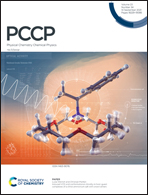Molecular mechanisms of resveratrol and EGCG in the inhibition of Aβ42 aggregation and disruption of Aβ42 protofibril: similarities and differences†
Abstract
The aggregation of amyloid-β protein (Aβ) into fibrillary deposits is implicated in Alzheimer's disease (AD), and inhibiting Aβ aggregation and clearing Aβ fibrils are considered as promising strategies to treat AD. It has been reported that resveratrol (RSV) and epigallocatechin-3-gallate (EGCG), two of the most extensively studied natural polyphenols, are able to inhibit Aβ fibrillization and remodel the preformed fibrillary aggregates into amorphous, non-toxic species. However, the mechanisms by which RSV inhibits Aβ42 aggregation and disrupts Aβ42 protofibril, as well as the inhibitory/disruptive mechanistic similarities and differences between RSV and EGCG, remain mostly elusive. Herein, we performed extensive all-atom molecular dynamics (MD) simulations on Aβ42 dimers (the early aggregation state of Aβ42) and protofibrils (the intermediate of Aβ42 fibril formation and elongation) in the absence/presence of RSV or EGCG molecules. Our simulations show that both RSV and EGCG can bind with Aβ42 monomers and inhibit the dimerization of Aβ42. The binding of RSV with Aβ42 peptide is mostly via π–π stacking interactions, while the binding of EGCG with Aβ42 is mainly through hydrophobic, π–π stacking, and hydrogen-bonding interactions. Moreover, both RSV and EGCG disrupt the β-sheet structure and K28–A42 salt bridges, leading to a disruption of Aβ42 protofibril structure. RSV mainly binds with residues whose side-chains point inwards from the surface of the protofibril, while EGCG mostly binds with residues whose side-chains point outwards from the surface of the protofibril. Furthermore, RSV interacts with Aβ42 protofibrils mostly via π–π stacking interactions, while EGCG interacts with Aβ42 protofibrils mainly via hydrogen-bonding and hydrophobic interactions. For comparison, we also explore the effects of RSV/EGCG molecules on the aggregation inhibition and protofibril disruption of the Iowa mutant (D23N) Aβ. Our findings may pave the way for the design of more effective drug candidates as well as the utilization of cocktail therapy using RSV and EGCG for the treatment of AD.



 Please wait while we load your content...
Please wait while we load your content...